
Original Link: https://www.anandtech.com/show/5564/capsule-review-corsairs-vengeance-m60-and-m90-mice
Capsule Review: Corsair's Vengeance M60 and M90 Mice
by Dustin Sklavos on February 22, 2012 2:45 PM EST- Posted in
- Peripherals
- Corsair
- Mouse
- Input Devices
The Corsair Vengeance M60 and M90 Gaming Mice
Here's a prickly subject if ever there were one: while with keyboards you could reasonably argue for the superiority of using mechanical switches over traditional rubber-dome membrane keys, mice are much, much more a matter of preference. A mouse could have all the features you're looking for, but if the grip isn't right or the texture makes you hand clammy the whole enterprise can be a bust. Understanding how delicate the balancing act of a good mouse can be, Corsair has come up with matching mice for their new gaming keyboards.
The new Vengeance M60 is geared for FPS players with an innovative "Sniper" button while the M90 targets MMO players who'll use as many configurable buttons as they can find. In terms of styling and intended use, the M60 theoretically should be paired with the K60 keyboard while the M90 goes with the K90, though you can obviously mix and match as you see fit. The real question is how well they actually work in practice.
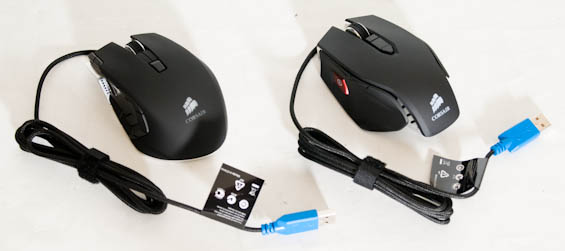
Corsair Vengeance M90 (Left) and M60 (Right)
While Corsair's Vengeance keyboards had a pretty obvious progression, with the K90 being almost directly superior to the K60, the mice are definitely different creatures, sporting very different features and different grips. The only commonality between the two lies in the sensors (both use lasers rated for up to 5700dpi) and the ability to adjust sensitivity between three settings on the fly using Corsair's Dashboard software.
They also come with different price tags, though the difference isn't as great as the keyboards: the FPS-oriented M60 runs $59, while the MMO-oriented M90 clocks up at $69. These are fairly high prices but still essentially comparable to similar products from other vendors (and actually substantially cheaper than a lot of Razer's offerings).
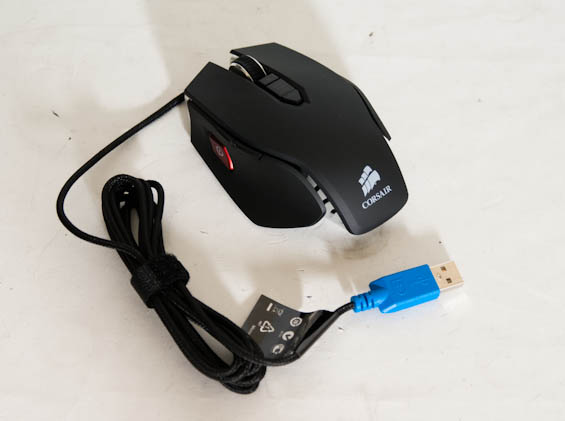
The Vengeance M60 sports the standard mouse button configuration (left and right, middle mouse on the mouse wheel) along with back and forward buttons on the left side. Corsair's innovation here is the "Sniper" button, the big red button on the left side that, while held, drastically reduces the mouse's sensitivity to allow for more precise aiming. Below the mouse wheel is the mouse sensitivity indicator along with the sensitivity adjustment buttons, but it bears mentioning that all of these buttons can be reconfigured in Corsair's software. The underside of the M60 also features something the M90 lacks: three removable weights.
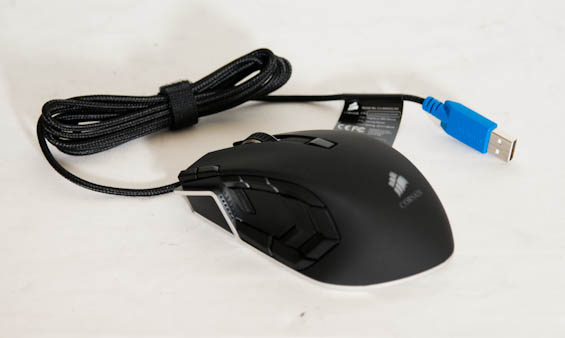
For the Vengeance M90, Corsair ditches the open-bodied grip and substantially changes the left side of the mouse. The sensitivity buttons are relocated to the top left next to the left mouse button, and then the thumb grip region includes a staggering nine configurable buttons. This is very different from the Razer Naga, which has twelve buttons arranged in a three-by-four grid; Corsair has essentially designed the M90 to have a button within range no matter where you click.
Like the M60, all of the M90's mouse buttons are configurable, and you can even configure a button with the M60's "Sniper" function. With the M90 you also gain a toggled backlit logo under the palm, but you lose the adjustable weight.
Finally, both mice come with braided cables, and neither comes with a software disc: you'll have to download Corsair's Dashboard from their website. It's probably just as well; I can't remember the last time I actually needed a driver disc and didn't just download the most recent drivers.
The Vengeance Mice in Action
Given their reasonably different shapes and designs, the Corsair Vengeance M60 and M90 have noticeably different feels. Both enjoy the same soft touch plastic shell and Corsair's default sensitivity of 2600dpi was surprisingly close to the mark (for me at least), and both use Corsair's Dashboard. Yet the shapes and grips of the mice felt noticeably different, and their functionality proved a little more fraught in practice than it was on the page. Tracking and response were excellent, but when you get into the features are where things fall apart.
In Productivity
For basic browsing and productivity tasks, there's still really no substitute for a wired mouse. Responsiveness of both mice was fantastic and well ahead of even the best wireless mice I've used (including Logitech's classic MX Revolution). Yet the mountain of buttons on the M90 proved to be a hindrance for basic web browsing; on the M60 the back and forward buttons are right where they should be, just the right size, and have a reasonable amount of travel and resistance. The M90, on the other hand, configures those navigation buttons far to the rear of the button cluster. Honestly, to look at the M90, you'd be hard pressed to even figure out which buttons would make the most sense for those.
Over time I also found the soft plastic surfaces of both mice would cause the palm of my hand to get clammier than normal. This is an issue I've had with every Razer mouse I've used, including my old Microsoft Habu (which was developed with Razer); my primary mouse before testing these was a Logitech G500, and the smooth but textured plastic surface felt a lot better and didn't cause me to sweat as much.
In Gaming
The responsiveness carried over to my gaming experiences with both mice, where I had little trouble getting the proper amount of precision. If you're not married to using any of the functionality of either of these mice, they're actually excellent just in terms of the basics.
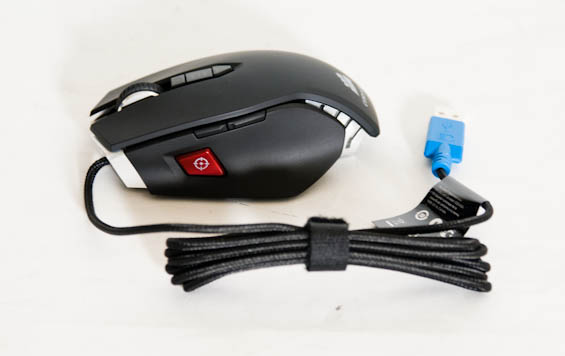
Once again, though, problems creep up when you do start to try and use their features. The "Sniper" button of the M60 (and assignable in the M90) is a useful function in theory, but in practice it feels like something I'd have to get used to. I had friends try out the mice as well and the response was similar: it's a great idea but something you would have to adapt to. That's not unreasonable. There's also the placement of the "Sniper" button. On the M60, for my hands and the way I grip the mouse, it's just too far up the left side. The button needed to be lower to be under where my thumb usually rests. Again, time to adjust is the name of the game, but whether you're willing and able to do so will vary by user.
The M90's button cluster would probably be awesome for die hard MMO gamers, but I found the placement and resistance of the buttons ever so slightly off. Oftentimes it felt like I would have to press the buttons too hard to get them to register, and I never did find a way to configure them exactly how I wanted them, even for basic internet navigation much less gameplay. Where I could actually find myself adapting to the Sniper button on the M60 given enough time, the learning curve for the M90 feels substantially steeper and I'm not sure I'd ever get fully comfortable with the mutlitude of buttons and their locations.
Corsair's Software
If you read my review of the Vengeance keyboards, this is going to be pretty familiar to you. You can configure the functionality of either mouse in software, but you can also program macros and functionality directly into the hardware.
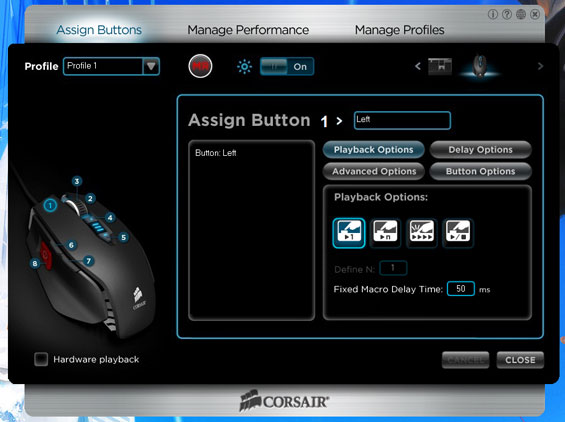
The macro functionality and button assignment configuration is just as unintuitive as the keyboard's software, and once again I find myself lamenting the lack of media controls. I have my G500 configured to control media playback; the on-the-fly sensitivity adjustment buttons are used to skip tracks forward and back, and then the third thumb button is used for play/pause. None of this is possible with Corsair's software. It's a small nuisance and one they can hopefully easily rectify. The unusual and unintuitive nature of the button assignment screen is a little more troublesome, though. In the screen above, you'd expect the box next to "Assign Button 1>" to be the function the button performs. That's actually not true; that box is just a label, it's the long box beneath it that lists what the button does.
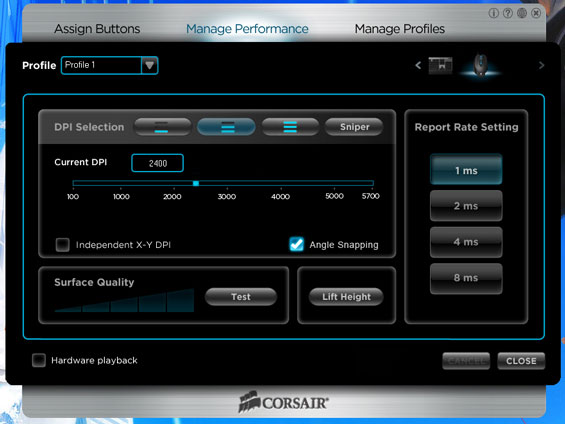
The "Manage Performance" tab is much less of a headache, though, and is actually very useful. I don't have any real complaints here; this is pretty much as simple and easy to understand as they could conceivably make it, and I appreciate them actually listing the DPI numerically instead of just having the slider. Now instead of saying "about...there is comfortable" you can know "about...2400dpi is comfortable."
My biggest complaint about Corsair's peripheral software is that it's not unified. For each mouse and for the Vengeance K90, you actually have to download and run three completely separate installers, with the irony being that eventually they all do tie in together. You can see from the screenshots that on the top right there's a toggle between peripherals, so why isn't there just one download package for all of the Vengeance peripherals? This is one place where Logitech has an edge; SetPoint's interface may be bloated, but you only have to download the one application to manage all your Logitech peripherals and it keeps them fairly separate and orderly.
Conclusion: A Matter of Taste
Despite my criticisms I'll readily admit the Corsair Vengeance M60 and M90 are two of the better mice I've tested. While I prefer the feel of the body of the M90, the button arrangement of the M60 was more comfortable for me. Either way, these two mice are excellent at what they were fundamentally designed to do: they're fast, responsive, and precise. The benefit of gaming hardware is that oftentimes it's engineered with better precision and quality in mind, making the Vengeance mice a decent option for regular users who have no interest in gaming. The M90, for example, could certainly be very useful for someone who uses heavy duty CAD or video software and needs a lot of shortcuts on the mouse.
The problem you run into is that it's going to be a matter of taste and preference. Peripherals like these can be a very personal thing; while a friend of mine quite liked the Vengeance mice (and indeed preferred the M90), another found the mice to be too large and bulky and preferred to continue using a Microsoft Bluetooth Notebook Mouse 5000 that fit her hand and her grip style better. Personally, I do find them both on the large-ish side and they feel like they were designed for hands bigger than mine. The special buttons never seemed to be in the right place for me the way the side buttons on the Logitech G500 are.
Thankfully, Corsair is getting pretty good market penetration and the prices for the M60 and M90 are reasonable, so it shouldn't be too hard for you to go out and actually see them for yourself in person as opposed to just taking my word for it. Quibbles about button placement (and even surface treatment of the body's plastic) can be very subjective, and what bothers me could very likely not bother you—or you might even like something I dislike.
That said, the software side of things still needs work. The interface honestly needs to be cleaned up a lot and made more intuitive, and just bout everything I brought up in the Vengeance keyboard review is applicable here. The DPI configuration screen is excellent, but the button assignment and macro programming remains baffling. I think Corsair erred on people being more apt to use the software to program macros than basic functions, but why shouldn't it be designed to cater to both?
When all is said and done, though, the software is the easiest thing to fix. If the hardware wasn't there the mice would be a lost cause, but for the most part the hardware is fine. I have personal issues with the layouts of the mice, but you may not share my complaints. If the M60 or M90 feel good in your hand, they're probably going to be right for you.













